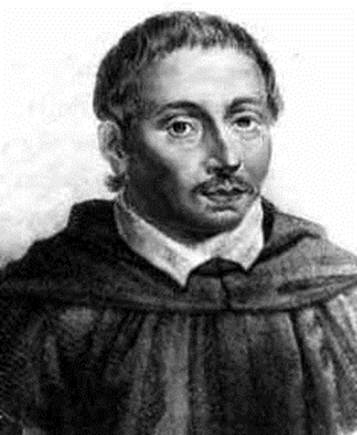


 تاريخ الرياضيات
تاريخ الرياضيات
 الرياضيات في الحضارات المختلفة
الرياضيات في الحضارات المختلفة 
 الرياضيات المتقطعة
الرياضيات المتقطعة
 الجبر
الجبر
 الهندسة
الهندسة 
 المعادلات التفاضلية و التكاملية
المعادلات التفاضلية و التكاملية 
 التحليل
التحليل
 علماء الرياضيات
علماء الرياضيات |
Read More
Date: 12-1-2016
Date: 26-10-2015
Date: 17-1-2016
|
Born: 1598 in Milan, Duchy of Milan, Habsburg Empire (now Italy)
Died: 30 November 1647 in Bologna, Papal States (now Italy)
 Bonaventura Cavalieri joined the religious order Jesuati in Milan in 1615 while he was still a boy. In 1616 he transferred to the Jesuati monastery in Pisa. His interest in mathematics was stimulated by Euclid's works and after meeting Galileo, considered himself a disciple of the astronomer. The meeting with Galileo was set up by Cardinal Federico Borromeo who saw clearly the genius in Cavalieri while he was at the monastery in Milan.
Bonaventura Cavalieri joined the religious order Jesuati in Milan in 1615 while he was still a boy. In 1616 he transferred to the Jesuati monastery in Pisa. His interest in mathematics was stimulated by Euclid's works and after meeting Galileo, considered himself a disciple of the astronomer. The meeting with Galileo was set up by Cardinal Federico Borromeo who saw clearly the genius in Cavalieri while he was at the monastery in Milan.
In Pisa, Cavalieri was taught mathematics by Benedetto Castelli, a lecturer in mathematics at the University of Pisa. He taught Cavalieri geometry and he showed such promise that Cavalieri sometimes took over Castelli's lectures at the university.
Cavalieri applied for the chair of mathematics in Bologna in 1619 but was not successful since he was considered too young for a position of this seniority. He also failed to get the chair of mathematics at Pisa when Castelli left for Rome.
In 1621 Cavalieri became a deacon and assistant to Cardinal Federico Borromeo at the monastery in Milan. He taught theology there until 1623 when he became prior of St Peter's at Lodi. After three years at Lodi he went to the Jesuati monastery in Parma, where he was to spend another three years.
In 1629 Cavalieri was appointed to the chair of mathematics at Bologna but by this time he had already developed a method of indivisibles which became a factor in the development of the integral calculus.
Cavalieri's theory of indivisibles, presented in his Geometria indivisibilibus continuorum nova quadam ratione promota of 1635 was a development of Archimedes' method of exhaustion incorporating Kepler's theory of infinitesimally small geometric quantities. This theory allowed Cavalieri to find simply and rapidly the area and volume of various geometric figures.
The method of indivisibles was not put on a rigorous basis and his book was widely attacked. In reply Cavalieri improved his exposition publishing Exercitationes geometricae sex which became the main source for 17th Century mathematicians.
Cavalieri was also largely responsible for introducing logarithms as a computational tool in Italy through his book Directorium Generale Uranometricum. The tables of logarithms which he published included logarithms of trigonometric functions for use by astronomers.
Cavalieri also wrote on conic sections, trigonometry, optics, astronomy, and astrology. He developed a general rule for the focal length of lenses and described a reflecting telescope. He also worked on a number of problems of motion. He even published a number of books on astrology, one in 1639 and another, his last work, Trattato della ruota planetaria perpetua in 1646.
Cavalieri corresponded with many mathematicians including Galileo, Mersenne, Renieri, Rocca, Torricelli and Viviani. His correspondence with Galileo includes at least 112 letters. Galileo thought highly of him writing
few, if any, since Archimedes, have delved as far and as deep into the science of geometry.
Perhaps Cavalieri's most famous student was Stefano degli Angeli. He studied with Cavalieri at Bologna at a time when Cavalieri was quite old and suffering from arthritis. Angeli wrote many of the letters which Cavalieri sent to his fellow mathematicians during his time of study.
Books:
Articles:



|
|
|
|
دراسة: عدم ترتيب الغرفة قد يدل على مشاكل نفسية
|
|
|
|
|
|
|
علماء: تغير المناخ تسبب في ارتفاع الحرارة خلال موسم الحج
|
|
|
|
|
|
|
اختتام مؤتمر الإمام الرضا (عليه السلام) ضمن فعاليات أسبوع الإمامة الدولي الثاني
|
|
|